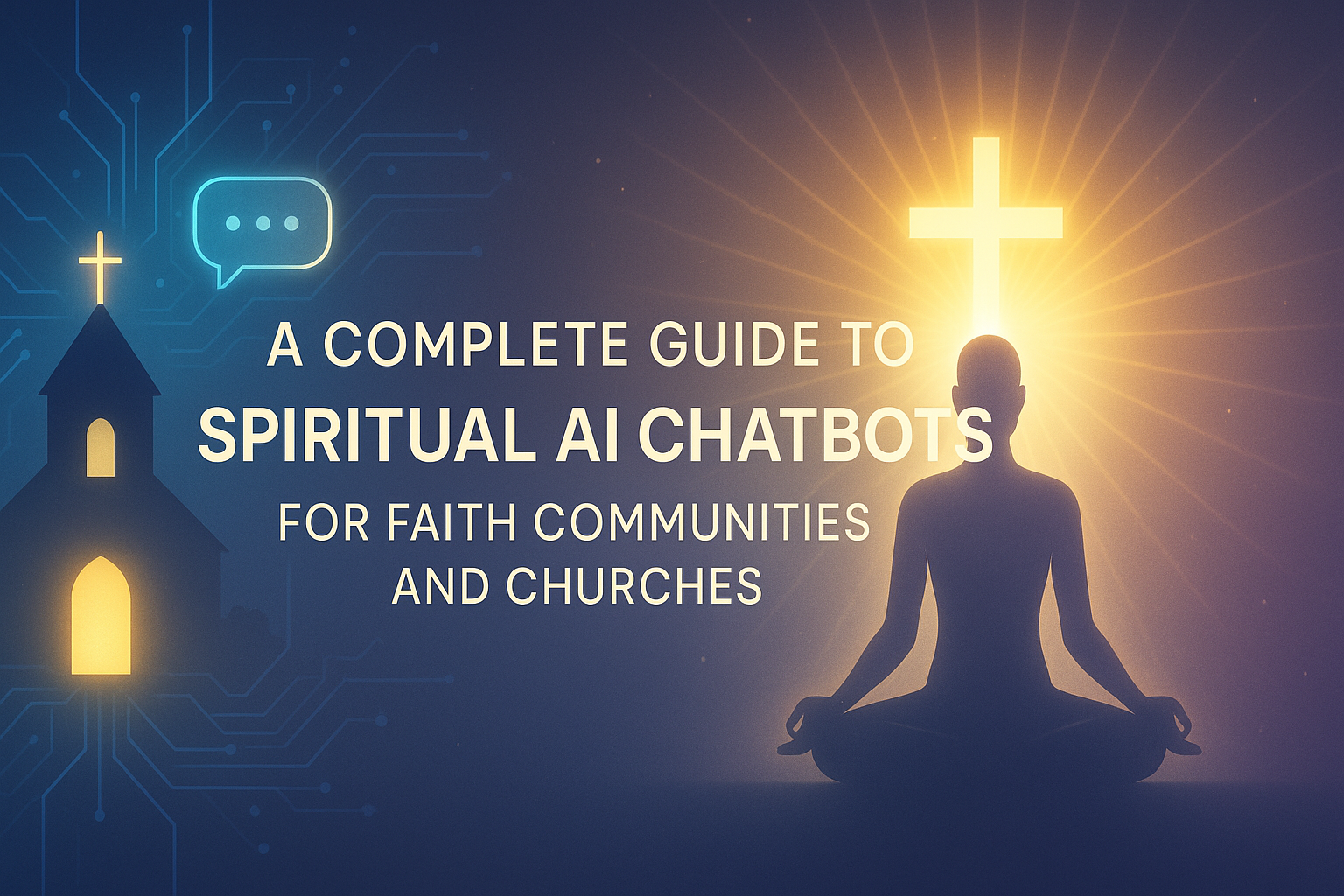A Complete Guide to Spiritual AI Chatbots for Faith Communities and Churches

Introduction
Spiritual AI Chatbots for faith Communities are changing how churches and faith groups connect with people. These chatbots can answer questions, share prayers, guide visitors, and help staff with tasks. This guide explains what they are, how they work, and how your community can use them safely and well. It is written in a clear and friendly way so anyone can understand.
What is a Spiritual AI Chatbot?
A spiritual AI chatbot is a computer program that talks with people in natural language. It may chat by text, voice, or both. It uses artificial intelligence to understand questions and give helpful answers. For faith communities, these chatbots are tuned to share spiritual resources, Bible verses, prayer ideas, service times, event info, and pastoral care options.
Why this matters: Chatbots are available 24/7. That means someone can get spiritual support or answers even outside office hours.
Why Faith Communities Are Using Chatbots
-
Always-on support: People can ask questions any time.
-
Reach more people: Chatbots can serve many users at once.
-
Lower staff load: Volunteers and staff spend less time on simple requests.
-
New paths to care: Chatbots can offer prayer prompts, counseling referrals, or emergency contact info.
Many churches see chatbots as a tool to widen their ministry while keeping care personal and kind.
How Spiritual AI Chatbots Work (Simple)
At a basic level, a chatbot needs three parts:
-
Input: User types or speaks a question.
-
Understanding: The AI figures out what the user means.
-
Response: The chatbot replies with text, voice, or links.
Behind the scenes, an AI Chatbots development company or a tech team sets up the rules, the training data (like scriptures, sermons, FAQs), and the integrations (like calendar or donation systems).
24 Key Ways Spiritual AI Chatbots Help Faith Communities
Below are 24 clear and practical ways spiritual chatbots can support your church or faith group. Each point explains the benefit and how it might look in real use.
-
Welcoming New Visitors
A chatbot can greet website visitors, offer a short welcome message, and guide them to service times or visitor forms. This helps make first impressions warm and instant. -
Answering Frequently Asked Questions
Common questions (service times, location, dress code) get instant answers. This frees volunteers to focus on deeper care. -
Offering Daily Devotions and Scripture
The chatbot can send a short daily devotion or verse by request, helping people build steady prayer habits. -
Prayer Request Intake
Users can submit prayer requests. The bot can offer to pass them to prayer teams, keep them private, or give suggested prayers. -
Crisis and Resource Guidance
For urgent needs, the bot can show emergency contacts, hotlines, and local resources, and advise contacting a human leader. -
Event Sign-Ups and Reminders
The chatbot can register people for events and send reminders via text, email, or push notification. -
Volunteer Scheduling
Volunteers can check shifts and sign up. This reduces email chains and missed posts. -
Donation and Giving Support
The bot can guide users through giving options and link to secure donation pages, easing the giving process. -
Bible Study Assistance
It can suggest study guides, summarize passages, or propose discussion questions for groups. -
Faith Education for Kids and Youth
Age-appropriate content, games, and simple Q&As help young learners engage safely. -
Counseling Intake and Referral
The chatbot can collect basic info and suggest next steps, while protecting privacy and directing users to trained counselors. -
Language Support
Chatbots can offer translations or content in multiple languages so congregations with mixed languages feel included. -
Accessibility Help
Voice features and clear text make resources available to people with visual or reading challenges. -
Sermon Archives and Summaries
Users can ask for past sermons, get short summaries, or find related themes and scripture references. -
Personalized Spiritual Paths
By asking a few questions, the bot can suggest a next step—like joining a group, reading a book, or starting a prayer plan. -
Youth Safety Filters
The chatbot can block harmful content and route concerning messages to adults or trained leaders. -
Feedback Collection
After an event or service, the bot can ask a few quick questions to gather helpful feedback. -
Onboarding New Members
New members can receive a short orientation, links to groups, and ways to connect. -
Small Group Matchmaking
By asking about interests and availability, a bot can suggest the best small group or Bible study to join. -
Worship and Song Requests
Members can suggest songs or ideas for services, and leaders can view these in one place. -
Legal and Safety Prompts
The bot can remind volunteers about background check steps, child safety rules, or important policy links. -
Local Outreach Coordination
For community service, the chatbot can share needs, sign people up, and coordinate drop-off points. -
Seasonal Campaign Support
During holiday drives, campaigns, or vacation Bible school, the bot can manage registrations and share updates. -
Analytics and Insights for Leaders
Chat logs and user trends help leaders see what people ask most, so ministries can adapt and plan.
Designing a Friendly Spiritual Chatbot
Creating a helpful chatbot is more than tech; it’s about tone.
Design tips:
-
Choose a friendly, respectful voice.
-
Keep answers short and clear.
-
Use scripture and theology carefully; add a note when the bot is not a substitute for pastoral care.
-
Offer human contact options often: “Would you like to speak to a staff member?”
A well-designed bot feels like a caring guide, not a cold machine.
Important Ethics and Privacy Rules
Faith groups must protect trust and safety.
Key rules:
-
Confidentiality: Treat prayer requests and counseling details as private.
-
Transparency: Tell users when they’re talking to a bot.
-
Consent: Ask before storing personal info.
-
Safe referrals: For mental health or crisis messages, have a clear path to human help.
Follow local laws for data protection and consult your legal team if needed.
How to Choose an AI Chatbot Development Company
When you need help building the bot, look for a trusted AI chatbot development company or vendor. Here’s how to pick one.
Checklist:
-
Experience with faith groups or nonprofits.
-
Clear privacy and security policies.
-
Examples and references.
-
Easy-to-use editing tools for leaders.
-
Integration ability (calendar, giving, CRM).
-
Affordable pricing and clear support options.
Ask for a demo focused on real ministry tasks. A good company will show how the bot serves real people, not just tech specs.
Technical Setup — Step by Step
A simple roadmap for getting started:
-
Plan goals: List 3–5 things the bot must do (e.g., answer FAQ, collect prayer requests).
-
Choose a platform: Website chat, Facebook Messenger, WhatsApp, or an app.
-
Pick a vendor or DIY tool: Decide between an AI Chatbots development company or a user-friendly builder.
-
Gather content: FAQs, sermon summaries, contact info, and prayer guidelines.
-
Train and test: Try sample chats and refine tone.
-
Launch small: Start with one channel (like the website) and grow.
-
Monitor and improve: Use feedback and analytics to refine replies.
Training the Chatbot with Your Community’s Voice
Make the chatbot sound like your church.
How to train:
-
Collect real questions people ask.
-
Write sample answers with your voice.
-
Add scripture references carefully.
-
Give the bot phrases volunteers use.
-
Test with a small group before public launch.
Training keeps the bot helpful and consistent.
Integrating with Church Systems (Giving, Calendar, CRM)
Integration makes the chatbot powerful.
-
Calendar: Let people see upcoming events and sign up.
-
Giving systems: Provide secure links and giving options.
-
CRM (Member Database): Let the bot look up basic info (with permission).
-
Email systems: Send welcome messages or follow-ups automatically.
Make sure integrations follow privacy rules.
Cost and Budget Considerations
Costs vary. Here are common lines to budget for:
-
Setup fee: One-time cost for building and training.
-
Monthly hosting: For the bot platform and AI requests.
-
Integration fees: Connecting with your payment or CRM.
-
Maintenance: Updates, new content, and training.
-
Support: Help desk or consultant time.
A small community can start affordably; larger setups need more funding. Ask potential vendors for clear price breakdowns.
Measuring Success — Metrics That Matter
Track these to know if the bot helps:
-
Number of chats started per week.
-
Completion rate: Did users get the answer they needed?
-
Conversion actions: Event sign-ups, giving, volunteer enrollments.
-
Human handoffs: How often users ask to talk to a person.
-
User satisfaction: Simple thumbs-up or short surveys.
Use metrics to improve the bot, content, and outreach.
Common Challenges and Solutions
Challenge: Bot The gives wrong answers.
Fix: Add more training data and monitor logs.
Challenge: People prefer humans.
Fix: Make human handoff easy and fast.
Challenge: Privacy worries.
Fix: Be open about data rules and limit stored personal data.
Challenge: Language mix in the congregation.
Fix: Offer multilingual options and clear translations.
Best Practices for Ongoing Use
-
Update content monthly.
-
Keep personal data minimal.
-
Train volunteers to use the bot and handoffs.
-
Run small surveys twice a year.
-
Celebrate wins and share stories of impact.
A chatbot is most helpful when it grows with your community.
A Short Example Case Study
Grace Community Church launched a spiritual chatbot on its website. Goals: welcome visitors, collect prayer requests, and share weekly devotionals.
What they did:
-
Hired a small AI chatbot development company to build the bot.
-
Trained it on 200 real questions from their inbox.
-
Launched in one month and promoted it in the bulletin.
Results after 3 months:
-
1,200 chats started.
-
300 prayer requests logged, 90% handled by volunteers.
-
40 new event sign-ups from bot referrals.
Leaders said the bot saved staff time and helped reach people who would not otherwise connect.
FAQs
Q1: Are spiritual chatbots replacing pastors?
A: No. Chatbots help with simple tasks and first contact. They cannot replace human care, counseling, or leadership. Always include clear options to reach a real person.
Q2: Can a chatbot be trusted with prayer requests?
A: Yes, if privacy rules are set. Train the bot to ask permission before sharing, and keep sensitive requests private and secure.
Q3: Do chatbots understand scripture well?
A: They can provide scripture references and short explanations but should not offer deep theological advice without human review.
Q4: How do we keep the bot theologically accurate?
A: Create and review the bot’s answers with church leaders. Use a small theology review team to approve content for sensitive topics.
Q5: How long does it take to set one up?
A: A simple bot can be set up in a few weeks. More complex bots with integrations and heavy training can take 1–3 months.
Conclusion
Spiritual AI Chatbots for faith Communities are powerful tools when used well. They help churches welcome guests, collect prayer requests, support volunteers, and keep people connected day and night. Choose a trusted AI chatbot development company if you need technical help. Keep privacy, ethics, and human care at the center of your plan. Start small, learn fast, and grow the bot as your community’s needs change.
If your faith group is thinking about a chatbot, start with one clear goal, like handling FAQs or prayer requests, and build from there. When done with care, a spiritual chatbot can be a gentle, helpful presence that expands your ministry and deepens community care.








